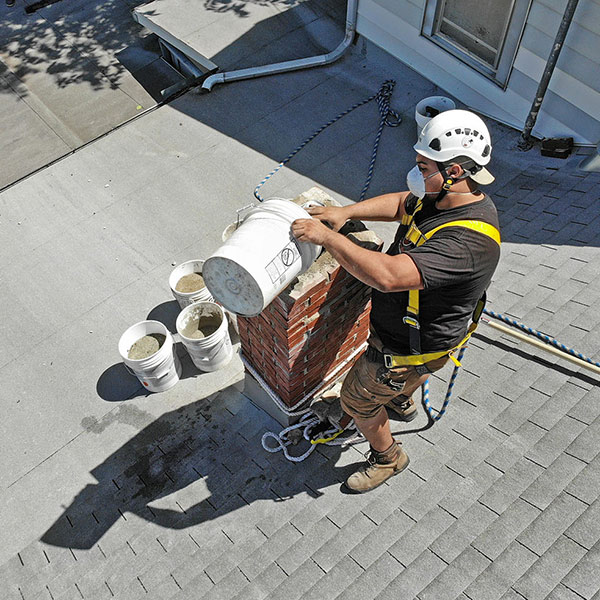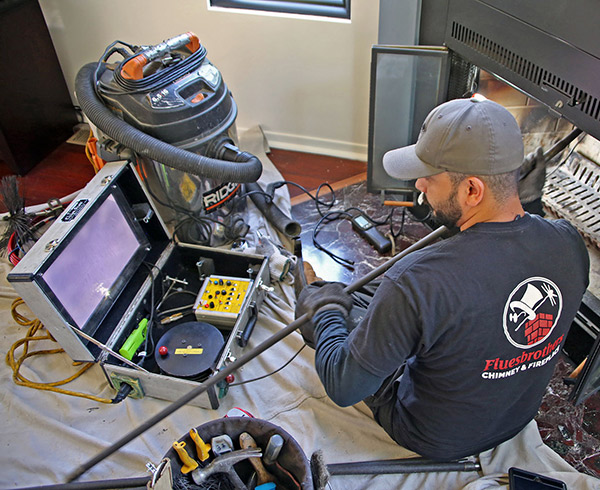Winters are hard on chimneys, often leaving them with damage that could lead to serious problems if not addressed. For this reason, the best decision you can make for your chimney is to have it professionally inspected after the winter burning season so that any needed repairs can be made well in advance of the next winter.
Here are some of the common ways chimneys can be damaged by winter weather.
 Chimney Masonry Damage
Chimney Masonry Damage
Intense cold weather can wreak havoc with chimney masonry. When mortar joints crack because of old age, lightning strikes, pounding hail or for other reasons, water can get into the cracks and start a cycle of deterioration. Freezing water expands, pushing outward against the mortar and causing internal damage. A lot of loose bricks and large sections of crumbling mortar make a chimney unsafe to use or live around.
Chimneys also can suffer damage from the inside, when there are breaks or cracks in the chimney liner. In this case, harmful combustion gases can lead to brick and mortar deterioration that the average homeowner won’t be able to spot. A cracked chimney crown (see below), a damaged or missing chimney cap and warped or damaged roof flashing are other ways chimney masonry can be compromised during a long winter. All masonry issues are best addressed by a CSIA-certified chimney inspector.
Damage to the Chimney Crown
When your cement chimney crown begins to crack, water can move in and do the same kind of damage it does to bricks and mortar. Crowns are built at the top of chimneys to protect the bricks below them and the internal flue spaces outside the flue pipes. If only minor cracking is present, the crown often can be waterproofed to avoid further decay. Severely cracked chimney crowns usually need to be rebuilt.
Issues with Leaky Chimneys
Chimney leaks can be caused by masonry damage, crown damage, a compromised or missing chimney cap, warped flashing and more. Most homeowners can spot certain signs of a leaky chimney, but few individuals can easily determine where the leak is coming from and the extent of the damage that’s causing it. If you have any of the following chimney leak symptoms, schedule a chimney inspection prior to using the fireplace again.
- Strong, musty odor coming from the fireplace
- Water on the floor and walls of the firebox
- White discoloration on the exterior chimney masonry
- A damper that can’t be fully opened or closed
- Wetness on sections of walls or the ceiling adjacent to the fireplace
Creosote and Soot
Excess creosote and soot that forms after a long burning season can damage your chimney and lead to a chimney fire. Creosote can be sticky, solid, puffy or flakey and is unavoidable if you use a wood-burning fireplace. Highly flammable, creosote is the cause of most chimney fires in the U.S. each year.
A professional chimney sweep uses electronic brushes and cleaning rods, scrubbers, solvents, vacuums and other equipment to dislodge and remove creosote and soot from chimneys. Sweeps also remove tree debris, small-animal nests and other obstructions that could cause smoke and deadly carbon monoxide to back up into your home.
 Schedule a Chimney Inspection
Schedule a Chimney Inspection
When winter is over, it’s time to have your chimney inspected. With annual inspections, you’ll be able to quickly uncover damage to the chimney structure and its components and get the problems repaired before significant (and expensive) damage occurs.
If it’s been awhile since your chimney was last looked at by a certified professional, contact Fluesbrothers Chimney & Fireplace of Kansas City, KS, today.
We provide inspections, chimney sweep services, chimney repair and rebuilding and more. Call us at (913) 236-7141.



